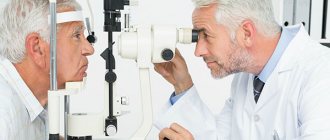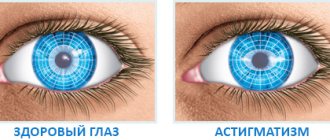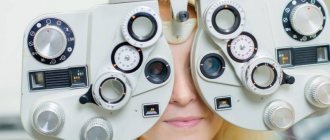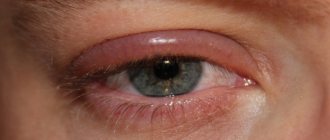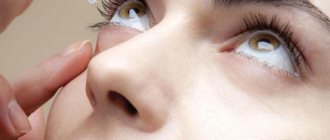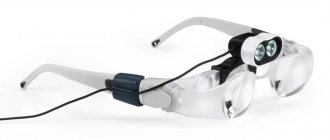Today there is a computer in almost every home. It has become an integral part of the life of a modern person, which is used not only for entertainment, but also for work. However, in the process of working at a PC, a lot of strain is placed on the eyes. When reading small print, they have to strain a lot, as a result of which, after a certain period of time, fatigue and muscle strain develop. As a rule, after just a few hours of work, the visual organ begins to hurt and the user finds it difficult to focus. However, many do not attach much importance to this problem, which is actually much more serious than it might seem at first glance. You also cannot be completely sure that the reason is precisely fatigue and is not associated with any disease.
To maintain productivity, every person should have an idea of how to relieve eye strain after computer use. There are several proven methods that are highly effective, which will be discussed later in this article.
Symptoms of asthenopia
Before we talk about how to quickly relieve eye tension, let’s first understand the features of its manifestation. Fatigue of the visual organ is called “asthenopia” in medicine. Like any other pathology, it is accompanied by certain clinical manifestations. The most problematic thing is that this syndrome has similar symptoms to some ophthalmological diseases, so it is very difficult to distinguish them on your own. Typical signs of eye fatigue include the following:
- pressing pain;
- redness of the whites;
- sensation of burning, stinging and itching;
- painful sensations from bright light;
- dry eye syndrome;
- black spots or spots before the eyes;
- increased fatigue;
- nervousness;
- bruises under the eyes.
The presence of several of the symptoms listed above indicates fatigue. To get rid of it, you need to relieve tension from your eyes. The best option is to take a short break from work, about 15-20 minutes, look into the distance outside the window and do a few simple exercises. You can learn more about the most effective methods below.
Facial massage - eye exercises for diplopia
Before starting the exercise, you need to relax the muscles of the face, especially around the eyes. Starting from the inside of the eyebrow, use a rotational motion, using light pressure, and move towards the outer edge. Continue moving in a circle until you reach the beginning of the eyebrow again. If you wish, you can use almond oil or onager oil. It will be useful to create various movements with the facial muscles. — Grimaces, for example, so as to involve all parts in the movement, from the lips to the eyelids. Take breaks for a couple of minutes, and then continue the exercise again later. This will not only relieve dullness in your eyes, but will also help preserve the youth of your face longer.
Main causes of fatigue
Today, quite a lot of people turn to specialists with eye problems. The most important thing is not to delay, otherwise the consequences can be very different. There are various ways to relieve eye strain at home, but the specific one you choose depends on the factor behind it. Among the most common causes of asthenopia, doctors identify the following:
- working with large amounts of text;
- The brightness of the display backlight is too high;
- incorrect posture when sitting at the computer;
- incorrectly selected screen color scheme;
- strabismus;
- lazy eye syndrome;
- dysfunction of the autonomic nervous system;
- working on a PC without safety glasses;
- osteochondrosis;
- arterial hypertension;
- low level of lighting in the room;
- poor quality nutrition;
- low air humidity in the room;
- avitaminosis;
- too exhausting diets;
- consequences of taking certain medications;
- chronic increased intraocular pressure;
- sleep disorder;
- diabetes;
- hormonal disbalance;
- inflammation of the paranasal sinuses;
- poor environmental conditions in the region of residence;
- blepharoplasty.
This is only a small part of all the possible reasons that may be behind asthenopia. As you can see, some of them are associated with various serious diseases. With them, it will be impossible to relieve eye tension on your own at home without consulting a doctor, since any pathology requires appropriate treatment. Therefore, if you have any vision problems, it is best to go to the hospital.
What to do?
Many people are interested in the question of how to relieve eye muscle tension. And this is not surprising, because today almost every person spends at least several hours a day at the computer. According to qualified specialists, there are many ways to relieve fatigue. However, it is best to try not to overload. It negatively affects eye health and can lead to the development of many serious diseases.
For comfortable work, it will be enough to take short breaks of about 5-10 minutes every hour. At the same time, it is better to refrain from using smartphones and other electronic gadgets. In addition, qualified doctors recommend periodically using drops to relieve eye strain. Pharmacies offer a huge range of drugs, and they are also available without a doctor’s prescription, so there should be no problems with the purchase. Next, we will consider the best medications in this group, which are highly effective and affordable.
Why do your eyes get tired while driving?
People often complain that their eyes get very tired while driving. This is due to the fact that they stare at the road, keeping their gaze motionless. But if you look at it correctly, driving can be a useful workout for your eyes!
Try to look around you often. Travel with your eyes along the horizon, along the white stripe of the highway. Then look into the distance to your left, noticing that nearby objects are quickly “running” past. Now also look to your right.
When moving around the city, move your gaze along with turning your head from one side of the street to the other. Then alternately look at the speedometer and then look far into the distance.
Eye drops
They will be the best option when there is no free time, but you need to quickly relieve eye strain. What drops are best to use? The choice of medications is very wide, but when purchasing you need to take into account one important nuance. Such treatment refers to radical methods. This is due to the fact that it is aimed at relieving symptoms, and not at eliminating the cause of the problem.
Among the best eye drops that relieve tension and fatigue are the following:
- "Taufon";
- "Oftagel";
- "Vizin";
- "Systane";
- "Okumetil";
- "Lamp";
- "Riboflavin".
Any eye drops that relieve eye tension have a very fast effect. The result of their use becomes noticeable just a few minutes after instillation. But it is not recommended to start using them without first consulting your doctor. All drugs belong to different groups that have specific effects. For example, some relieve fatigue, while others improve tear production or normalize blood circulation. Each specific case requires an individual approach.
Exercises
If you don't want to use anti-stress eye drops, there is another good option. There are several special exercises that effectively help with asthenopia. Here's one of the best:
- Switch your gaze from the monitor screen to the window and try to focus your vision on any object located in the distance. It can be anything. The main thing is that the object is as far away as possible.
- After 10-15 seconds, focus on the objects located in the room. For example, this could be a pen lying on the table at a distance of about 25 centimeters.
- This procedure is repeated several times until you feel an improvement and the sharpness returns to your eyes. Finally, you need to blink quickly for a while. This stimulates the lacrimal glands, which has a positive effect on the hydration of the cornea.
Some drops that relieve eye tension help strengthen and tone muscle tissue. But the same effect can also be achieved with the help of some exercises. For example, you can close your eyes for a few seconds, trying to tense your eyelids as much as possible, and then take a break for the same amount of time. The cycle must be repeated 5 to 10 times. The following technique will also help cope with severe eye fatigue:
- Take a deep breath and hold your breath briefly, closing your eyes for 6-8 seconds. The muscles of the cervical region and the front of the head should be as tense as possible. As you exhale, your eyes open as wide as possible. To achieve a good result, you need to perform several repetitions.
- Rotate your pupils, trying to draw a figure eight with them in a horizontal position 10 times. After this, do the same number of exercises, but the figure should now appear vertical. To stay hydrated, blink continuously as you move.
- Press your temples with your fingers. Calculate the force so that you feel it, but do not experience pain. Blink for a while in this position, then relax your eye muscles, rest a little and do a few more approaches.
Such exercises are as effective as medications and will quickly relieve eye strain. Moreover, this kind of gymnastics is safe for health, while drops are made on the basis of various chemicals that have not only a positive effect, but also some harm.
How often to drip when working at a computer
It is advisable to decide with your doctor which drops to choose for eye fatigue. It is important to discuss the frequency and duration of medication use. When using several products at the same time, find out in what sequence and at what intervals to use them correctly.
Depending on the drug, drops are instilled 4-5 times a day; some moisturizing solutions can be used up to 10 times. Replacing the medication is necessary if there is a need for more frequent instillation than indicated in the instructions.
Alternative medicine
Many people who spend a lot of time at the computer every day are interested in how to relieve tension from the eye muscles using traditional methods. There are many good recipes that can be used for asthenopia. Here are some of them:
- Finely chop fresh parsley leaves, wrap them in gauze and soak in boiling water for 30 seconds. After the compress has cooled to a comfortable temperature, apply it to your eyes for a quarter of an hour. Instead of greens, you can use mashed potatoes.
- For excessive eye strain, regular tea is a universal remedy. For example, if you have some tea bags left, you can warm them up a little and apply them to your eyes for 20 minutes.
- Soak cotton pads in milk heated to 40-45 degrees and apply to closed eyelids for 30 minutes. When the required time is over, the compress must be removed and be sure to wash with warm water.
- Wash a fresh cucumber, cut a couple of circles and place them on your eyes for half an hour.
- Mix one teaspoon each of dried chamomile and linden flowers, add water and bring to a boil. Next, remove from heat, add 60 grams of honey, stir well and let it brew a little. Rub your eyelids with the resulting product every day before bed. Such procedures not only help to cope with fatigue, but also relieve inflammation, and also normalize the circulation of lymph and tissue fluid in the eyeballs.
Now you know how you can relieve eye strain at home without using medications or performing gymnastic exercises. But be careful as self-medication can have many serious consequences. To reduce the risk of their development, you should first consult with a qualified specialist.
Do glasses worsen vision?
There is an opinion that glasses spoil your eyes. That if you start wearing them, your vision will deteriorate even more. This is not entirely true. This idea also came from Bates, but later he changed his mind and stopped recommending giving up glasses. This is understandable. After all, we already know that vision deteriorates from stress. And if you have to strain and squint all the time to see something, then this is clearly not good for your eyesight.
I suggest a middle ground. Wear your glasses where you need them. This is called situational wearing. If you have a slight degree of myopia and you only have poor distance vision, then carry glasses with you and put them on only when you need to see something in the distance. Most often, such people need glasses to see the bus number or read signs in the subway, as well as while driving and in the theater.
Even if your vision has deteriorated greatly, and you feel very uncomfortable without glasses, then try to do without them in your usual home environment. Even with high degrees of myopia, it is quite safe to get ready for work and have breakfast without glasses.
The correct selection of glasses and wearing them correctly play a big role. Undercorrection of vision is not as bad as overcorrection. That is, glasses that are too strong cause a lot of stress and can impair vision. Moreover, human vision is a variable value that can change several times during the day depending on external and internal factors.
You've probably noticed that on a sunny day everything is visible more clearly than on a cloudy one. When you feel unwell, have high blood pressure and at the end of the day, your vision deteriorates. Therefore, it is better to come for a vision test and glasses selection in the first half of the day, after sleep and rest.
People who wear glasses for close work should know that wearing these glasses cannot see further than half a meter. Otherwise, your vision will quickly deteriorate. For long distance there should be weaker glasses if they are needed.
It is also recommended for nearsighted people to have different glasses for different distances. Then your eyes will be as comfortable as possible. For myopic people, glasses with maximum distance correction should not be worn in the office and should not be used for computer work. It is better to order separate computer glasses.
And it’s not just that these glasses have a filter that protects against harmful blue radiation from screens. Also, these glasses should be about 1 diopter weaker than long-distance glasses. Otherwise, you end up with the same overcorrection - distance glasses are too strong for such a short distance, and the eyes in them quickly get tired.
Progressive glasses
There are glasses with so-called progressive lenses. Outwardly, they are no different from ordinary glasses, but at the same time they have different lens powers for different distances, precisely selected for your vision. This is very convenient, one glasses instead of two or three. And if you make them photochromic (darkening in the sun), then you get four glasses in one.
You don’t need to take them off or put them on, they are always on you and always comfortable for your eyes to look at. There are glasses for 2 distances, usually the computer zone and the reading zone. These glasses will also make it convenient to communicate with your interlocutor and move around your home or office. Another type of progressive lenses is designed for 3 distances: distance, medium distance and near. You can drive a car comfortably in them, as you can clearly see the whole road and the navigator with the dashboard. But this type of glasses has a rather narrow middle zone, and may not be very comfortable at the computer.
Prevention of asthenopia
Above we discussed in detail how to relieve fatigue and tension from the eyes. But doctors say that it is better to prevent this, since asthenopia very often leads to the development of many serious diseases. The following preventive measures will help reduce the risk of health problems:
- regular scheduled examinations by an ophthalmologist;
- wearing glasses or contact lenses if you have vision problems;
- timely treatment of any eye pathologies;
- working at a computer wearing special safety glasses;
- minimal use of cosmetics;
- take the choice of eye cream seriously;
- quality rest;
- proper nutrition, rich in vitamins and minerals;
- maintaining correct body position while reading;
- breaks when working at the computer or watching TV for a long time.
The measures listed above will reduce eye strain and reduce the risk of developing many ophthalmological diseases. The main thing is not to be lazy, but to do them regularly. This is especially important if, due to your professional activities, you sit at the computer for a long time or play a lot.
Pain in the eyes is not a disease, but a symptom
A feeling of acute discomfort, called pain in the eyes, is a symptom that occurs due to many reasons. Many people have experienced these unpleasant sensations.
Most often, pain in the eyes is a symptom that accompanies damage or injury to the tissue of the eyeball. Rarely, pain in the eyes indicates a pathology of the nervous system.
Pain in the eyes itself is not a disease. It indicates the presence of such.
Many causes for one symptom
There are many reasons for pain in the eyes.
More precisely, the cause can only be determined by an ophthalmologist after a thorough examination. However, you should know the most common reasons:
- Inflammation. Pain in the eyes may indicate diseases such as conjunctivitis or keratitis, as well as warn of the development of various inflammatory processes in the tissues of the eyeball. It should be remembered that pain in the eyes in case of inflammation will be accompanied by redness of the tissues, swelling of the eyelids or eyelids, and lacrimation. Factors that cause inflammatory processes can be varied, from caustic volatile chemicals (in this case, we will be dealing with an allergic reaction) to bacteria and viruses.
- Damage to the eyelids, uveitis and blepharitis also contribute to the development of the symptom. The disease is accompanied by profuse lacrimation and photophobia.
- Foreign bodies of the conjunctiva (specks, midges, eyelashes, grains of sand, microscopic fragments).
- Viral, infectious diseases (flu, measles, herpes virus).
- Demodicosis (damage to the hair follicles of the eyelashes by parasites, microscopic mites).
- Inappropriate glasses or contact lenses, which may be outdated or too hard.
- Visual fatigue due to hard work (this often happens to those who are forced to spend a long time in front of the screen).
- Trigeminal neuralgia. The disorder is easily distinguished by the presence of pain not only in the eye area, but also in the face and mouth.
Blue screen is harmful to your eyes
Dry eye syndrome is the scourge of our time. It most often affects office workers.
Three factors contribute to the development of the syndrome:
- Fluorescent lighting.
- Air conditioning in the room.
- Working at the computer.
The listed factors contribute to disruption of the hydration process of the eyeball.
The violation is caused by:
- High degree of visual stress.
- Rarely blinking.
- Immobility of the eyeball.
With electric, often insufficient, improper lighting, in a closed room where the air is dry, the reasons quickly lead to the fact that the production of tear fluid is disrupted, and the properties of the tear film covering the front of the eyeball also change.
The tear film no longer protects the eye from exposure to dry air and microscopic dust particles.
Eliminate pests
If pain in the eyes occurs, you should not wait for events to develop, but be sure to consult a doctor.
Before visiting a doctor, you should take care of your eyes and, first of all, eliminate the influence of factors that can increase discomfort.
These factors are:
- Cosmetics (mascara, eye shadow, powder).
- Allergens.
- Incorrectly selected low-quality glasses or contact lenses.
- Excessive visual stress.
- Microclimate in the working area.
Diagnosis and treatment methods for pain in the eyes
Treatment will depend on the identified cause. Diagnostic measures to determine the cause of pain in the eyes include:
- A swab from the surface of the eye in case of suspected inflammation.
- Special tests that are used to detect dry eye syndrome.
- Scraping from the eyelids.
Having determined the cause, the ophthalmologist prescribes treatment. Treatment measures vary:
- Eye drops and ointments containing an antibiotic (in case of infectious diseases, inflammations).
- Moisturizing eye drops (artificial tears) for established dry eyes. The purpose of such drops is to cover the front of the eyeball with a protective, moist film.
- Preparations that are applied to the eyelids help cope with demodicosis.
- Surgical intervention may be required in case of mechanical damage to the eye or detection of a foreign body.
Clean and protected
Prevention measures are simple and include rules of hygiene and eye protection.
- Protective equipment (special glasses should be worn when visiting swimming pools, while working with household chemicals, varnishes and paints, and during professional activities associated with risk to the eyes).
- It is better to purchase high-quality cosmetics (mascaras, shadows), any other cosmetics in pharmacies or in trusted places.
- Avoiding allergens as much as possible.
- Sunglasses are designed to protect your eyes from bright sunlight and help you avoid overworking your eye muscles.
- Compliance with hygiene rules (you should not rub your eyes with your hands; if you need to blot your tears, you should use a clean disposable handkerchief).
- Proper wearing of contact lenses.
- Charger. Relevant for those who spend a lot of time in front of the screen. Experts recommend taking a ten-minute break every hour or two, using this time to do simple exercises. Move your eyes up and down, left and right, blink, rotate your eyeballs. Exercise helps relieve muscle tension, blinking promotes normal hydration of the eyeball.
- Good rest, coupled with good nutrition, rich in vitamins A and E, and sufficient fluids.
- Active lifestyle, walks in the fresh air.
When to sound the alarm?
As mentioned at the beginning of the article, visual discomfort is not always associated with eye strain due to prolonged work on a PC. According to doctors, very often it leads to the development of many health problems. Among the most common are the following:
- nervousness;
- fast fatiguability;
- deterioration of visual acuity;
- headache.
In addition, the syndrome significantly increases the risk of developing certain ophthalmological pathologies. The most commonly diagnosed are:
- myopia;
- hypermetropia;
- glaucoma;
- deformation of the lens or cornea;
- cataract;
- inflammatory eye diseases.
Any of the above pathologies not only negatively affects a person’s daily life, but can also cause partial or complete blindness. Therefore, it is very important to know how to relieve eye strain.
How to relieve muscle tension during neurosis, relaxation technique – Neurology
When a person is constantly in a stressful situation , relaxation techniques will help him.
If you have neurosis, unreasonable fears, or insomnia, use special exercises and meditation.
How to calm a loved one down? Advice from psychologists will help you!
What is the ability to relax?
Relaxation - what is it? Modern man is predominantly in a tense state.
We experience stress at work, on the way home, at home, watching the news on TV, browsing the Internet, visiting the clinic, shopping and in many other cases.
In this regard, there is a need to relax and unwind. But, unfortunately, a tired, exhausted body no longer knows how to do this.
Constantly being in tension, we lose the ability to relax. The result is headaches, poor digestion, heart problems, and fatigue.
Relaxation is the ability to escape from reality, to forget for a while about conflicts, stress, health problems, and failures.
This is an internal state of peace, calm . You forget for a short time about the stressors constantly affecting you, and feel peace.
The ability to relax is to find ways to bring you to a calm state.
Why am I always stressed?
I can't relax. The nervous system is working hard . The environment puts pressure on us, we are constantly forced to solve some issues, and additional stress factors affect us - noise, smells, poor ecology. This in turn causes internal tension.
Psychological and physical blocks and clamps appear, and then the moment comes when you are no longer able to fully relax.
All this is complemented by constantly present negative thoughts, experiences, and fears .
Living in big cities is stressful in itself. It is difficult for a modern person to deal with the everyday influences of the surrounding reality.
Have you noticed that when you are very tired, you cannot fall asleep quickly, and the sleep itself is intermittent and restless?
This happens because the nervous system is overstrained, excited, and difficult to calm down.
How to learn to relax properly?
The art of relaxation can be learned.
Quick ways
How to quickly relax and relieve tension? What to do if the body urgently needs rest, but there is little time for it:
- Become aware of your tension . At times of tension, stress hormones are produced that prevent you from calming down. It is important to understand the reason.
- Give yourself the opportunity to physically relax . Hit a punching bag, do pull-ups on the bar, do a few squats or sharp swings of your arms - activity will help work off the stress hormone.
- With a sigh, we raise our hands up, stretch as high as possible, then, exhaling, lower our hands.
- We sit down, hugging our knees and pressing our heads against them. We sit in this position for about 10 seconds, then relax.
- The following breathing exercise will help you relax : inhale, simultaneously filling and protruding your stomach, then your chest. We exhale, releasing the air from the chest, then lower the stomach.
Psychologically
In this case, the brain is involved in the relaxation process. Make him stop thoughts , especially negative ones.
As soon as you start thinking about something bad, tell yourself “stop.” Imagine an emptiness where there are no thoughts.
Learn to meditate. Sit in a comfortable position. A half lotus is well suited for this - legs crossed in front of you. Close your eyes. Breathe slowly and deeply.
Imagine a calm sea in front of you. The wind slowly blows across your face. You watch how the surface of the water is slightly agitated. You feel good and relaxed.
Remove clamps
Muscle armor is a chronic, constant tension of the muscles without the ability to fully relax them.
A closed mouth indicates that we are blocking the transmission of feelings and need protection. The following exercise will help relieve tension. Lie in the fetal position with your arms wrapped around yourself.
Start making sucking movements with your mouth. Many people shed tears during the process. There is no need to restrain yourself - this is how you get rid of clamps .
Throat and neck. Clamps in this area indicate a desire to control your fear, unacceptable reactions and statements.
You can understand the presence of blocks by a monotonous, tense voice. The person seems to be restraining himself.
Yawning will help get rid of the block in this area; sometimes we do it involuntarily. Open your mouth as wide as possible and yawn. Do the exercise in the morning and evening.
Rib cage. Blocks arise when we hold back sadness, laughter, passion .
Pay attention to your breathing - most likely it is shallow, delayed, without strong protrusion of the chest.
You can check for breathing problems by pronouncing the sound “A”. If you cannot do this within 20 seconds, then there are problems.
Psychotherapist Lowen developed the following breathing technique. You need to lie across the sofa, feet on the floor. We hang the buttocks slightly.
Place a bolster under your lower back to allow your chest to expand as much as possible. Place your hands above your head with your palms facing up. Breathe deeply and rarely.
Aperture . Tension in this place is associated with chronic fear. The exercise is performed standing. Bend your arms in front of you, relax your hands. Turn your body to the left as far as possible and stay there for 60 seconds.
Then in the other direction. The presence of muscle clamps can be determined by the fact that breathing is disrupted, pain appears, which means that muscle clamps are present.
To relieve tension, another exercise : lie on the floor, bend your legs at a right angle, place your arms freely, lower your legs to the right and left until they stop, your waist remains pressed to the floor.
Body from stress
Physical activity will help relieve tension:
- bend forward several times;
- stretch;
- turns the body to the right and left;
- raise your arms up, lean to the right, then to the left, stretching your arms;
- dancing to rhythmic music.
Breathing exercises are useful : when inhaling, the stomach protrudes, and when exhaling, it contracts.
Swimming will help relieve tension throughout the body .
Aromatherapy has proven itself well. Use special aroma lamps with oils, sticks or candles.
Add aromatic oils to a warm bath: before use, be sure to mix them with salt, otherwise they will remain in the top layer of water and can burn.
Brain after hard work
Long and intense work causes you to be unable to fall asleep and relax.
- take a warm bath with herbs, sea salt or aromatic oils;
- massage is useful, if it is not possible to massage the whole body, pay attention to the feet and lower legs;
- drink herbal tea with chamomile, lemon balm or mint;
- lie down comfortably, try to relax your muscles as much as possible. If you experience pain or swelling in your legs, place them on a slight elevation.
After stress
What to do if you are under severe stress and cannot calm down:
- Understand the cause of stress.
- Eliminate exposure to additional adverse factors: TV, showdowns, loud sounds.
- Do meditation.
- Go for a walk, ride a bike, spend time in nature.
- Take a warm bath with sea salt.
- Switch to another type of activity.
- Treat the situation correctly, do not take everything to heart, try not to react to little things.
- Minimize, or better yet eliminate, communication with unpleasant and annoying people.
- Watch an easy movie that doesn't require stress.
With husband
I can’t relax with my husband: what should I do? This problem is usually deeply psychological. If you cannot relax with your husband, it means that there are some kind of complexes, most often originating from childhood.
The ability to relax is also a factor of trust. How much do you trust your man? If you are embarrassed by him, afraid of criticism, you need to work with it.
What to do:
- start simple, don’t open up completely at once, do everything step by step;
- Leave the house together more often for recreational activities. Go for a walk, somewhere where you can feel at ease;
- organize joint activities, take part in family competitions, sports games;
- if you are embarrassed to expose yourself in front of your husband, do it gradually. For a romantic evening, light candles that provide low light but create a certain mood;
- take a relaxing bath with sea salt or aromatic oils;
- turn on soothing music;
- talk to each other more, share your experiences.
Tell your spouse what worries you. A loving man will understand and support .
Relaxation techniques for neurosis
Neuroses are mental disorders when causeless anxiety and psychological discomfort appear.
A person is constantly in a state of tension, negative emotions predominate , which directly affects well-being and relationships with other people.
For neuroses, a visit to a psychotherapist is recommended. If necessary, the doctor will prescribe medications.
During attacks, it is important to understand that anxiety comes from within. It is necessary to relieve muscle tension; the exercises described above are suitable for this. Meditation accompanied by calm music, sounds of nature or mantras is shown.
exercises with deep and slow breathing , which calm the nervous system, help well
Autogenic training. positive thoughts in oneself .
First you need to relax. We begin relaxation from the lower extremities, then the arms, stomach, throat, head. We breathe evenly and deeply.
- We imagine that we are exhaling dark smoke filled with negativity, and inhaling golden air filled with solar energy.
- Autogenic training can be accompanied by suggestions like: I am calm, I am relaxed, I react calmly to any influences, I am positive.
- Suggestions should be made in a positive way, that is, there should not be a “no” in them, but positive statements.
General tips and tricks
If you cannot imagine your life without a computer, then at least you need to work with it correctly. In order not to create a large strain on the eyes and avoid fatigue, you must adhere to the following rules:
- Place the light source from behind so that it does not hit your eyes.
- Wear safety glasses and shields when working on a computer.
- Eat foods rich in vitamins and carotene, which are necessary for sharp vision.
- Adjust the backlight and contrast on the monitor.
- Try to sleep at least 7 hours a night.
- Maintain a distance of at least 50 centimeters from the screen.
- Take breaks between work to give your eyes a rest.
- When reading or typing, increase the font size. This will reduce the load on the visual organs.
- Periodically wash your face with cold water and do gymnastic exercises for your eyes.
Medical statistics show that approximately 70 percent of people have vision problems. The tips and recommendations listed above will help you avoid being one of them.
How to watch movies correctly
Movies, watched correctly, are good exercise for the eyes! Video watching exercise.
In a movie theater, sit in the second or third row in the center of the theater. Take off your glasses, do some palming. Everything will be blurry at first. Look relaxed, without trying to see details. Blink frequently, move your eyes around the entire screen, and breathe deeply. Soon the image will begin to clear up. You will first be forced to put on your glasses before the session ends. But gradually your eyes will strengthen to such an extent that you will be able to watch the entire movie without glasses.
This exercise can also be done at home in front of the TV.
Sit close enough to the screen that you can't see very clearly but can still follow the story without straining. You need to sit straight, placing your head in line with your spine. Fresh air must enter the room.
Turn on a soft light source. The sharp contrast between the glowing screen and the darkness of the room creates additional strain on the eyes. Look at the screen as shown above. Palming periodically while continuing to listen to the sound.
During each viewing, sit at the same distance from the screen until the image is consistently clear. Then you can move a little further. Margaret Corbett describes an incident where one of her students started watching from the front row of a movie theater, but just a month later was able to see with the same clarity from the back row of the balcony!
